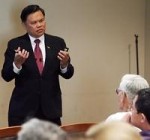Lim’s speech reveals progress

Right after the 9/11 terrorist attacks and the subsequent anthrax scares, the U.S. military had no sophisticated way to test for bacteria in water. Its method: placing small fish in the water.
“It’s been the same way since the 1800s,” said Daniel Lim, a distinguished professor from the USF Biology department during a University Lecture Series (ULS) speech called “Biosensors, Bugs and BioDefense” on Thursday.” We have not moved very far in the last 200 years.”
Lim and his team of scientists and researchers are trying to change that. He talked of his department’s progress to about 1000 students and faculty the TECO Room in the College of Education building.
Lim talked extensively about a machine called the RAPTOR, which was developed by the U.S. military but is being expanded upon by Lim and his team.
The technologies available today have many shortcomings, Lim said: They take up too much time, require pure and clean samples, use equipment that is too sophisticated (it needs trained scientific personnel) and most importantly, give inaccurate results.
“(RAPTOR is) still not accurate enough,” he said. “Out of 10 or 12 tests, we’ll get one false alarm. What we’re doing is trying to make it more consistent.”
RAPTOR is the same size and weight of a car battery and can detect bacteria and other agents in a matter of minutes, as opposed to previous methods that take hours or, in some cases, even days. Also, nearly anybody can operate it.
“Somebody with no experience can just press a button and stand back,” Lim said.
But the RAPTOR is still far from being mass-produced and used routinely, Lim said.The RAPTOR needs a very large amount of bacteria to be present to produce a reliable test. Lim said his team is working to make the RAPTOR more sensitive.
“If you’re a terrorist, then you’re going to be using a large amount, so it will be able to detect it,” Lim said. “But if you’re testing a natural contamination, like E. coli in spinach, it won’t find it.”
Since the post-Sept. 11 anthrax scare, Lim and his team have been working extensively to develop quicker ways to detect bacteria and other bioterrorism agents in water, food and air.
“All of us were shocked about what happened five years ago,” Lim said. “But those of us in the scientific community were as equally shocked about the anthrax. We knew it could happen, but not so rapidly.”
Lim closed his speech by describing what his team has been working on, including research that shows promise of detecting tuberculosis more quickly than ever before, as well as a method that can test beach water for contamination with faster results.
“I think about how fortunate I am to work with these people,” Lim said. “They’re the most outstanding group of researchers in the U.S.”







